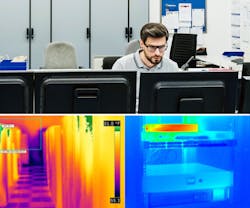Thermal Thrives in Data Centers
It is well known that thermal technology is ideal for large, complex enterprise applications such as airports, ports and energy facilities; however, savvy integrators are now finding new and creative uses for thermal technology – notably in data centers and server rooms. It is becoming a profitable new business opportunity for integrators focused both on SMBs as well as large commercial projects.
Whether the financial and business data is flowing into a full-sized data center or simply a small server room or even a server closet, that information is critical, and the servers need to be operational 24 hours a day, every day. To accomplish that, the servers need consistent power, cooling and support systems.
When a data center experiences equipment failure, the disruption of day-to-day business operations is often immediate – with financial losses that can be devastating to an organization compounding quickly. Thermal can be a vital tool to alert data center personnel of high heat – one of the biggest threats to the continued operation of a server environment.
Thermal Cameras Provide Early Warning
Malfunctioning or overheating equipment can lead to a fire – obviously a huge risk to a data center. By the time a smoke or fire is present, it is too late. Fortunately, thermal cameras can be used as early-warning devices to detect a rapid rise in heat, and thermal works long before smoke or sprinkler systems can detect this activity.
Thermal cameras also provide efficient preventative maintenance and proactive temperature-deviation alerts, which are critical for ensuring that data centers maintain their stringent uptime and availability requirements.
It is difficult to overstate the potential cost savings for businesses when it comes to protecting data center equipment; in fact, the cost could range from hundreds of thousands of dollars to even millions in some cases.
How Thermal Works
Thermal cameras are capable of seeing in the dark by using infrared imaging or thermography to detect radiant energy given off by objects – they do not need lights or a spark or fire to see changes in temperature. The hotter an object is, the more it radiates. Infrared imaging can detect an object’s heat signature and locates device hot spots within the environment.
In a data center, infrared thermography can detect “invisible” irregularities in electrical switchgear, UPS (uninterruptible power supplies), ATS (automatic transfer switches), server systems and cooling systems. Early, proactive detection of any irregularity in data center equipment gives the end-user time to make repairs and to avoid an unplanned shut down or catastrophic system failure.
In general, thermal technology will upgrade the resiliency of a data center’s critical facility infrastructure. There are multiple benefits: Thermal can identify system overheating; reduce the risk of undetected degradation of components due to overloaded circuits or loose connections; save costs associated with equipment failures and down time; and it can enable end-users to maintain a detailed equipment history.
A Growing Demand
The market for data centers is massive and growing. There are approximately 2,000 data centers in North America, with new construction projected to be aggressive through 2023; however, the market for SMB is much larger. As mentioned, just about all businesses have their own “data centers” in the form of a small server room or even a server closet. Regardless of where it is housed, thermal technology can detect overheating and other issues, in these servers.
I know integrators who have decided to install a thermal camera to protect servers in their own offices. In addition to keeping their valuable business data safe, they use it as a demo for end-user customers on how thermal technology works and benefits in a server room environment. They can even demo it remotely using a smartphone app – making it easy to show a customer the temperature readings and how the alerts work. It is a unique way to sell the technology.
The first question an integrator should ask potential clients is: How do you protect your servers? You will find that it is a question very few end-users have even considered; thus, it is an opportunity for integrators to become a trusted advisor in addition to being a revenue-generation opportunity. In fact, there is potential for recurring monthly revenue in this application if the thermal technology is coupled with monitoring and service contracts for thermal equipment monitoring.
Cost and Installation
When integrators think about thermal, they think expensive. While thermal cameras have historically been considered only for enterprise-level applications, the price point on newer cameras has come down significantly, making it a viable option for smaller applications.
The installation process is only slightly more complex than a standard camera. An integrator needs to set the alarm temperature on the camera itself and focus it properly. Manufacturers typically offer support and training for installers.
In addition to data centers, the market for practical and important use cases for thermal technology continues to grow. This year’s ISC West show presents an excellent opportunity for integrators to see thermal technology in action and to learn how it can help expand their businesses as an extremely effective first line of defense for the right customers.
Tony DeStefano is a Business Development Manager for Hikvision USA, who specializes in thermal technology. Request more info about Hikvision at www.securityinfowatch.com/10215768.
About the Author
Tony DeStefano
Tony DeStefano is a Business Development Manager for Hikvision USA, who specializes in thermal technology. Request more info about Hikvision at www.securityinfowatch.com/10215768.
